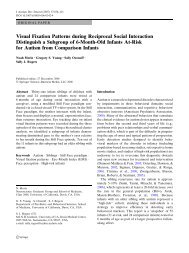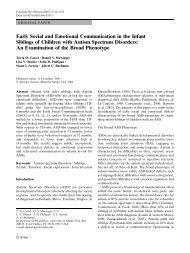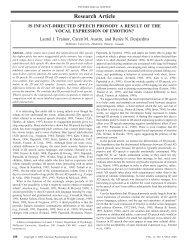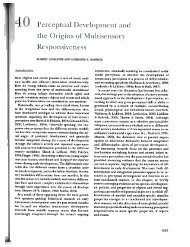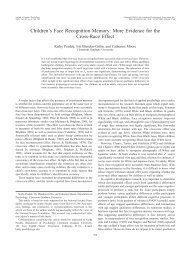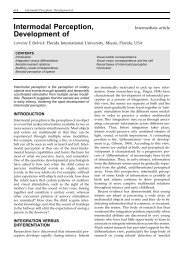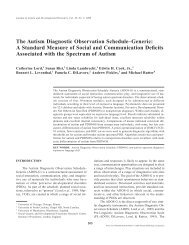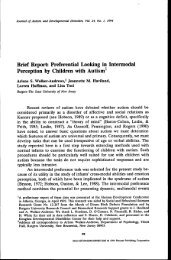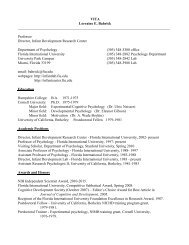The role of the mother's voice in developing mother's ... - FIU Infant Lab
The role of the mother's voice in developing mother's ... - FIU Infant Lab
The role of the mother's voice in developing mother's ... - FIU Infant Lab
You also want an ePaper? Increase the reach of your titles
YUMPU automatically turns print PDFs into web optimized ePapers that Google loves.
38<br />
F. Z. Sai<br />
RESULTS AND DISCUSSION<br />
<strong>The</strong> data were expressed <strong>in</strong> terms <strong>of</strong> PTLT <strong>in</strong>fants spent fixat<strong>in</strong>g <strong>the</strong> mo<strong>the</strong>r’s<br />
face on each trial. Look<strong>in</strong>g percentages for both trials were also averaged for each<br />
participant (Table 2).<br />
To assess <strong>the</strong> <strong>role</strong> <strong>of</strong> experience with <strong>the</strong> mo<strong>the</strong>r’s <strong>voice</strong> <strong>in</strong> facilitat<strong>in</strong>g<br />
recognition <strong>of</strong> <strong>the</strong> mo<strong>the</strong>r’s face, s<strong>in</strong>gle-sample t test were conducted on <strong>the</strong><br />
PTLTs to <strong>the</strong> mo<strong>the</strong>r’s face on trials 1, 2 and on <strong>the</strong> comb<strong>in</strong>ed trials (Trials 1 and<br />
2). As a group, <strong>the</strong> newborn <strong>in</strong>fants failed to significantly discrim<strong>in</strong>ate and<br />
recognize <strong>the</strong> face <strong>of</strong> <strong>the</strong> mo<strong>the</strong>r on trial 1 (tð13Þ ¼ 0:83, p ¼ ns), trial 2<br />
(tð13Þ ¼0:92, p ¼ ns), and on <strong>the</strong> comb<strong>in</strong>ed trials (tð13Þ ¼0:65, p ¼ ns). Figure 2<br />
displays <strong>the</strong> means percentage preference for <strong>the</strong> mo<strong>the</strong>r’s face across trials.<br />
Experience with <strong>the</strong> mo<strong>the</strong>r’s <strong>voice</strong> prior test<strong>in</strong>g seems necessary for mo<strong>the</strong>r’s<br />
face recognition. <strong>The</strong> question how much experience with <strong>the</strong> mo<strong>the</strong>r’s <strong>voice</strong>–<br />
face is needed for such learn<strong>in</strong>g to develop rema<strong>in</strong>s however, unanswered.<br />
Fur<strong>the</strong>r analyses were conducted to determ<strong>in</strong>e whe<strong>the</strong>r preference for <strong>the</strong><br />
mo<strong>the</strong>r differed as a function <strong>of</strong> condition and position <strong>of</strong> <strong>the</strong> mo<strong>the</strong>r’s face. <strong>The</strong><br />
performance <strong>of</strong> <strong>the</strong> <strong>in</strong>fants <strong>in</strong> Experiment 1 was compared to that <strong>of</strong> <strong>in</strong>fants <strong>in</strong><br />
Experiment 2. A mixed factorial design with condition (<strong>voice</strong> vs no <strong>voice</strong>) and<br />
side preferences (position <strong>of</strong> <strong>the</strong> mo<strong>the</strong>r on <strong>the</strong> right side vs left side) as ma<strong>in</strong><br />
factors revealed no ma<strong>in</strong> effects <strong>of</strong> condition (Fð1; 26Þ ¼3:09, p ¼ ns), side<br />
preferences (Fð1; 26Þ ¼0:001, p ¼ ns) or <strong>in</strong>teraction, condition X side preferences<br />
(Fð1; 26Þ ¼0:099, p ¼ ns). <strong>The</strong> results <strong>in</strong>dicated that although <strong>the</strong> newborn <strong>in</strong>fants<br />
showed no significant differences <strong>in</strong> <strong>the</strong>ir preferential behaviour across<br />
conditions, a slight preference for <strong>the</strong> mo<strong>the</strong>r was demonstrated <strong>in</strong> <strong>the</strong> <strong>voice</strong><br />
condition (Table 3). Fur<strong>the</strong>r, <strong>the</strong> <strong>in</strong>fants demonstrated a slight preference for <strong>the</strong><br />
mo<strong>the</strong>r’s face shown on <strong>the</strong> left side <strong>in</strong> <strong>the</strong> <strong>voice</strong> experiment. This pattern was<br />
however, reversed <strong>in</strong> <strong>the</strong> no-<strong>voice</strong> experiment. (Figure 3). Perhaps when <strong>in</strong>fants<br />
failed to discrim<strong>in</strong>ate between <strong>the</strong> two faces, <strong>the</strong>y tended to look more to <strong>the</strong> right<br />
side. This is consistent with early reports suggest<strong>in</strong>g significant head turns<br />
towards <strong>the</strong> right side <strong>in</strong> 3 month-old <strong>in</strong>fants (Gesell and Ames, 1947; Turkewitz<br />
et al., 1965). In a study by Bahrick et al. (1996) side preferences was however not<br />
significant at 5 or 8 months.<br />
An <strong>in</strong>terview was conducted with <strong>the</strong> mo<strong>the</strong>r and <strong>the</strong> female stranger at <strong>the</strong><br />
end <strong>of</strong> <strong>the</strong> test<strong>in</strong>g <strong>of</strong> each <strong>in</strong>fant <strong>in</strong> <strong>the</strong> no-<strong>voice</strong> experiment. We asked whe<strong>the</strong>r<br />
Figure 2. Percentage preference for <strong>the</strong> mo<strong>the</strong>r’s face across trials <strong>in</strong> <strong>the</strong> no <strong>voice</strong><br />
condition.<br />
Copyright # 2004 John Wiley & Sons, Ltd. Inf. Child Dev. 14: 29–50 (2005)



